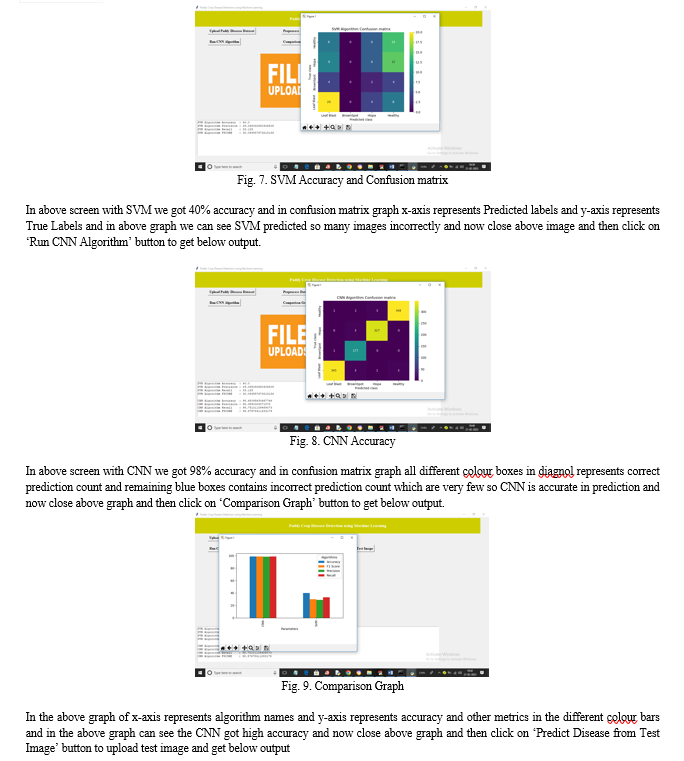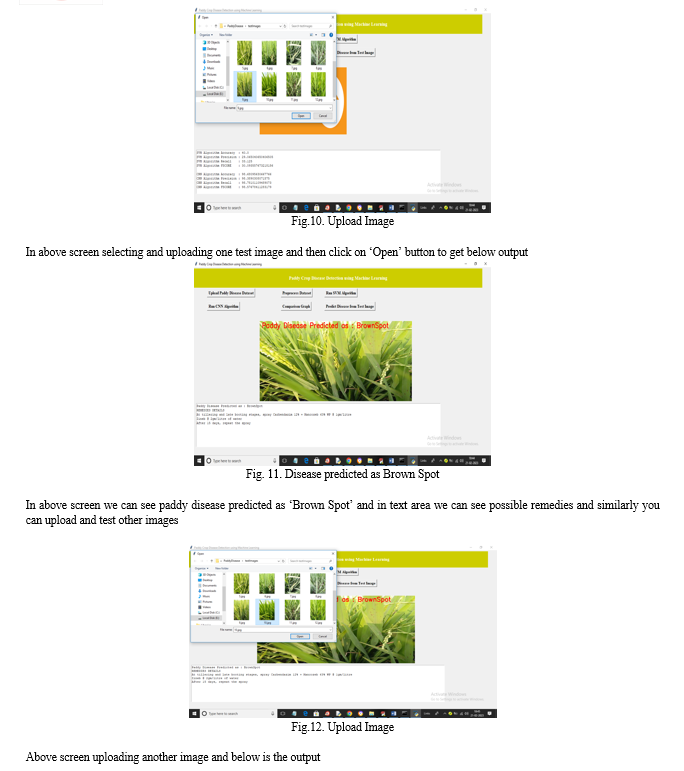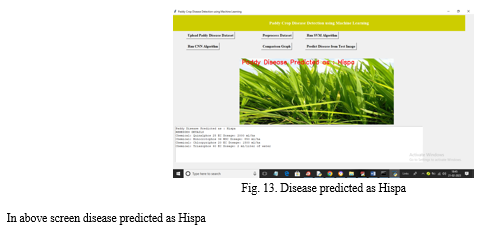Ijraset Journal For Research in Applied Science and Engineering Technology
- Home / Ijraset
- On This Page
- Abstract
- Introduction
- Conclusion
- References
- Copyright
Paddy Crop Disease Detection Using Machine Learning
Authors: K. Deepa Rao, G. Saahith Chandra, M. Vishnuvardhan Goud, A. Udayashree
DOI Link: https://doi.org/10.22214/ijraset.2024.59861
Certificate: View Certificate
Abstract
India has risen as a significant player in earlier years, the world’s second-largest producer of paddy, yielding approximately 497.7 million metric tons annualy. Sustaining vast paddy fields demand ongoing attention and upkeep. It is critical to recognize the symptoms and understand how this can effectively control the disease. Therefore, inspired by this research paper, a solution is suggested to train machine learning for identify diseases in paddy plants. The system utilizes rea;-time datasets sourced from the Agriculture Research Institute of Lonavala, which are freely accessible. This system can be used for identification purposes four major paddy plant diseases -Leaf Blast, Leaf Scald, Neck Blast and False smut. This Proposed system, first images are pre-processed and then the custom Convolution Neural Network is used to arranging the images. This project work discusses the methodology for disease identifying diseased leaves at an early At this stage, the suggested automated system can assist farmers in mitigating further harm to their crops.
Introduction
I. INTRODUCTION
Rice holds the status of being India’s most extensively cultivated crop, thanks to its high carbohydrate and protein content, alongside its capability to thrive in diverse environmental conditions. With over 1.2 billion people globally consuming it, rice occupies a central role in diet worldwide. For many small-scale rice mill vendors and farmers, rice stands as the primary source of income. They suffer a lot when the crops are affected by several diseases like Brown Spot (Helminphosporium Oryza), Hispa (Dicladispa Armigera), Leaf Blast (Pyricularia Grisea). These ailments present notable risks to rice cultivation. To address this critical issue, we developed a model capable of identifying and arranging diseases in affected plants using images captured a mobile camera. Our model utilizes a dataset containing 3,671 labeled images across four distinct rice disease categories for training purposes. We employ the TensorFlow inception v3 model, which incorporates Convolutional Neural Networks(CNN), to classify these images. Identifying diseased plants aids farmers in promptly recognizing the situation, enabling them to ascertain necessary chemicals and fertilizers for enhanced productivity. The outcome will produce the percentage of healthiness pertaining to the crop.
Monitoring systems use anomaly-based detection. The monitoring systems can identify whether system conditions and user behavior depart from the regular profile and assess whether an attack has occurred by constructing the target system and the user's normal behavior model. Once the DDoS attack is launched, the attack reaction is to appropriately filter or reduce the network traffic. To lessen the impact of denial-of-service attack, as little attack traffic as feasible is sent to the attack target site.
This system for detecting rice blast, Bacterial leaf and blight disease in paddy entails two primary phases of aspects involves training the model, while the other revolves around identifying disease-inflicted leaf images sourced from the Kaggle dataset. we’ve compiled a collection of 2000 images each depicting Leaf blast, Bacterial Blight, and healthy leaves. These images are instructed with the help of Convolution Neural Network (CNN) Algorithm.
Timely identifying diseases is crucial for safeguarding paddy crops. Previously, disease detection relied on visual inspection or laboratory examination. Visual observation necessitated expertise and could vary among individuals, leading to errors, while laboratory testing was time-consuming and might not yield results promptly. To address this challenge, we employed an image processing-based machine learning method to the detect and categorize diseases, with a primary emphasis on those affecting rice (Oryza sativa). The dataset comprises images depicting leaves and stems afflicted by diseases, sourced from paddy fields. It encompasses five distict diseases classes: Rice Blast, Bacterial Leaf Blight, Sheat Blight, and Healthy leaves. Early disease detection is paramount for farmers seeking to enhance their crop yields.
II. LITERATURE REVIEW
- Paper[1], Agriculture and Food
Levels of hunger have been increasing over the past five years. Each night, nearly 690 million individuals retire to bed with hunger gnawing at them.
The cultivation of food and agriculture activities hold paramount significance as they sustain livelihood for a large populace worldwide than any other sector. Our mission involves offering top-tier guidance to governments and lawn makers, aimed at bolstering nations’ food security and livelihoods.
We strive to enhance both public and private investments in agriculture and food systems, with a focus on improving quality.
Safeguard land tenure and conscientiously stewarding our natural resources are imperative tasks. Additionally, we aim to enhance the resilience of food systems and value chains to climate change. Our team of experts assists governments in enacting policies and regulations that empower food systems and communities to withstand climate-related disruptions.
2. Paper[2],The Nutrition Source
The Nutrition Source is a leading as an authoritative source of food and nutrition expertise, we offer science-based guidance for promoting healthy lifestyles.
Situated within the Department of Nutrition at Harvard T. H. Chan School of Public Health, The Nutrition Source delivers extensive nutrition resources via informationtive articles and FAQs.
Our collection of recipes and tools, such as The Healthy Eating Plate, facilitates the practical application of nutrition knowledge in daily life. Amidst a media landscape saturated with conflicting nutritional information, healthcare practitioners, journalists, and the public can depend on The Nutrition Source for independent, transparent, and impartial content, devoid of industry bias or sponsorship.
3. Paper[3], Hispa Disease of Rice
The rice hispa presents a notable menace to rice farming, particularly in Nepal’s Teral region, this pest is identified as a small, bluish-black bettle measuring 5mm in length. Distinguished by numerous short spines on its body and forewings, adults leave characteristic white parallel streaks along the leaf by scraping areas between the veins.
Eggs are typically located within the leaf tissue near the leaf’s apex. Upon hatching, the young grubs feed between the upper and lower layers of the leaf, tunneling downward. These legless grubs, sporting a creamy white colour, remain inconspicuous as they are concealed within the leaf tissues. They appear flattened and pale yellow in colour. Pupation occurs within the leaf mines they construct. In instances of severe infestation, leaves exhibit a whitening effect before ultimately perishing.
4. Paper[4], Convolutional neural networks: an overview and application in radiology
The Convolution Neural Network (CNN), a category of artificial neural networks, which has merged as a prominent tool in numerous computer vision endeavours, is garnering attention across diverse fields, encompassing radiology. CNN is engineered to autonomously and dynamically grasp spatial hierarchies of features through backpropagation, employing multiple components such as convolution, pooling , and fully connected layers.
This review provides insights into the fundamental principles of CNN and its utilizations in various radiological tasks, while also addressing challenges and future prospects in the radiology field.
Additionally, the article explores two key challenges encountered when applying CNN to radiological tasks-limited datasets size and overfitting-along with strategies to mitigate them. Acquiring familiarity with CNN’s concepts, benfits, and constraints is imperative for maximizing its utility.its potential in diagnostic radiology, with the goal of augmenting the performance of radiologists and improving patient care.
5. Paper[5], Blast leaf collar
Blast can manifest wherever blast spores exist. It is found in regions characterized by limited soil moisture, frequent and prolonged periods of rainfall, and cool daytime temperaturesIn upland rice, substantial day-night temperature variations, leading to dew formation on leaves and cooler overall temperatures, promote the disease’s development. Rice is susceptible to blast at all stages of growth. Nonetheless, the occurrence of leaf blast typically diminishes as plant mature and acquire immunity to the disease.
6. Paper[6], Disease Identification of Paddy Crops using Data Mining and Image Techniques
Image processing is the analysis and manipulation of a digitized image especially to improve its quality. The Data mining is the practice of examining large pre-existing databases to generate new information and it is process of selecting and exploring large amounts of data.
This process has become an increasingly aggressive action in all areas of agricultural sciences and research. There is the wealth of dispersed information regarding paddy crops.
This paper presents a novel approach to detect diseases in the paddy field and offer solutions to farmers. Utilizing high-resolution cameras or mobile devices such as Android or iphone, images of diseased paddy crops diseases and recommend remedies to farmers. This implementation offers an improved option for all segments of the agriculture community, particularly those in remote villages.
7. Paper[7], CNN feature based graph convolutional network for weed and crop recognition in smart farming
Weed removal significantly enhances crop yields. Ensuring dependable and precise weed identification is essential for achieving precise, site-specific weed management in precision agriculture. To improve the weed and crop recognition accuracy, utilizing a graph convolution network is based on CNN features and (Graph Convolutional Network) was built by utilizing extracted weed CNN features along with the corresponding Euclidean distance. Considering the semi-supervised learning, the GCN graph enriched the model by exploiting labelled and unlabelled image features, and testing samples obtain label information from labelled weed data by performing propagation over the graph.
III. PROPOSED MODEL
In this technique for identifing the leaf blast and Bacterial leaf blight disease of paddy, we are used Convolutional Neural Network (CNN) Algorithm is employed. The process consists of two primary phases: one pertains to training the model, while the other entails detecting the provided image of the disease. In the initial phase, the model is trained using an image dataset comprising both hygenic and diseased leaf images. The dataset includes 2000 images each of Rice blast, Bacterial Blight, and healthy paddy leaves. The datasets are sourced from the Kaggle website, are utilized in conjunction with the help of Convolutional Neural Network (CNN) Algorithm for training purposes.
A. Data Flow Diagram
Data flow diagram illustrate how the data is processed by the system in terms of the inputs and the outputs. Data flow diagrams serve as effective tools for illustrating the intricacies of various business functions in clear and concise manner. The technique starts with an overall picture of the business and continues by analysing each of the functional areas of intrest. This analysis can be carried out with in precisely in the level of detail required. The technique exploits a method called top-down expansion to conduct analysis in a targeted way
As the name suggests, Data Flow Diagram(DFS) is an illustration that explicates the passage of information in process. A DFD can be easily drawn using simple symbols. Aditionally, complicated processes can be easily automated by creating DFDs using easy-to-use, free downloadable diagramming tools. A DFD is the model for making and analyzing the information processes. DFD illustrates the flow of information in process depending upon the inputs and outputs. A DFD can be referred to the Process of a Model. A DFD demonstrate business or technical process with a support of outside data saved, plus the data flowing from the process to another and the end results.
B. External Interface Requirements
- User Experience: This system's user interface is made in an approachable Python visualisation.
- Device Interfaces: In order to facilitate communication between an operator and the console, Python features are employed.
- Interfaces in Software: Software built using Python is required.
- Operating Conditions: Microsoft Windows XP.
- Hardware Specifications: Pentium-IV processor with a speed of 1.1 GHz, 256 MB of RAM, 20 GB of hard drive space, a standard Windows keyboard, a two- or three-button mouse, and an SVGA monitor are required.
- Software Prerequisites: Windows 7/8 is the operating system, while Python is the programming language.





Conclusion
In summary, employing for rice crop infection identification through machine learning presents a groundbreaking opportunity in agricultural innovation. Through utilizing Convolutional Neural Network algorithms and image analysis methods, we\'ve demonstrated the capability to swiftly and accurately identify diseases, enabling proactive measures to safeguard crop health and optimize yields. While the potential of machine learning in this domain is evident, it\'s crucial to address challenges such as acquiring high-quality training data and mitigating biases in model predictions. Moreover, ongoing refinement and adaptation of machine learning systems are essential to ensure their effectiveness in real-world agricultural contexts. By overcoming these obstacles, the integration of machine learning technologies into crop infection detection stands to revolutionize farming practices, empowering farmers with actionable insights to make informed decisions and maximize productivity sustainably. This not only enhances food security but also contributes to broader efforts in agricultural sustainability and resilience in the face of evolving environmental and economic challenges.
References
[1] Dr. Raghavendra , Mrs. Shruti U, Dr. Nagaveni V B K “A survey of machine learning classification methods for detecting plant diseases” presented at the 5th (ICACCS) International Conference on Advanced Computing & Communication Systems 2019. [2] V. Vanitha “Rice disease identification using deep learning”, An (IJRTE) International Journal in Recent Technology and Engineering, Vol 7, Issue 5S3, Feb2019. [3] Md. Abu Nasim, Md. Jahid Hasan, Shamim Mahbub, Md. Shahin Alom “Rice infection identification and classification by integrating support vector in machine learning with deep convolutional neural network”,2019. [4] Anuradha badge “ leaf disease identification using Machine learning : Indian agriculture”, International Research Journal of Engineering and Technology (IRJET) ,05issue :09, Sept 2018. [5] Mrs Divya unni, Anjali K Arya M.S “Detection of Diseased plant leaves using image processing and genetic algorithm with arduino”,2018. [6] Zexin Guan, Qing Yao, Yingfeng Zhou “Application in support vector machine for detecting rice diseases using sharp and color tecture features” International Conference on Engineering Computation , 2019. [7] Mr Ramachnadra Hebbar, Pooja R, Mr.P.V Vinod, Shima Ramesh, Niveditha.M, Shashank.N, Prasad Bhat.N, “Plant disease Identification using machine learning”, 2018. [8] D. Vydeki, S Ramesh, “Rice blast disease Identification and classification using Machine learning”,2018. [9] Sarvepalli Jaahnavi, Karunya Rathan, Abirami Devraj, K. Indira, Sarvepalli Jaahnavi “Identification of Diseased plant using image processing technique”, April 4-6, 2019. [10] G Arulvadivu, R P Narmadha, “Identification and measuring the rice leaf disease using dataset processed”, ICCCI, Jan.05-07, 2017.
Copyright
Copyright © 2024 K. Deepa Rao, G. Saahith Chandra, M. Vishnuvardhan Goud, A. Udayashree. This is an open access article distributed under the Creative Commons Attribution License, which permits unrestricted use, distribution, and reproduction in any medium, provided the original work is properly cited.

Download Paper
Paper Id : IJRASET59861
Publish Date : 2024-04-05
ISSN : 2321-9653
Publisher Name : IJRASET
DOI Link : Click Here
 Submit Paper Online
Submit Paper Online

